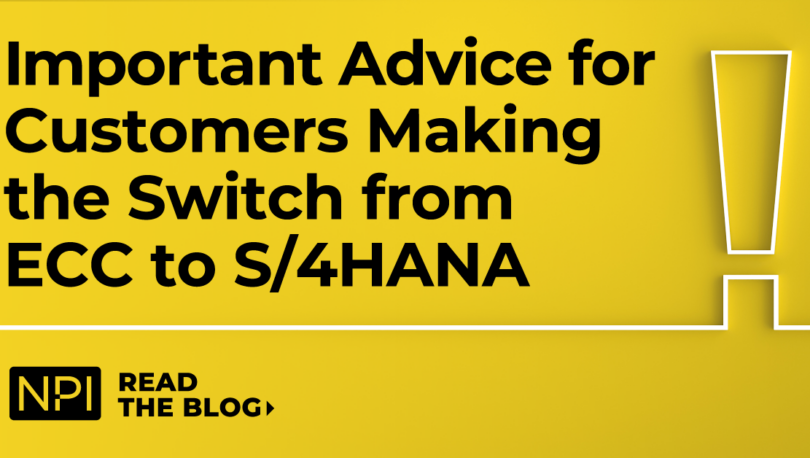The pressure for SAP customers to convert from ECC, its legacy ERP platform, to S/4HANA looms large in 2023. Despite the fact that mainstream support for ECC ends in 2027, most customers are struggling to make the switch. Recent data indicates 69% of ECC clients have not yet licensed S/4HANA. That’s a concerning number as the window to begin making changes grows surprisingly short.
The timeline to make the changeover from ECC to S/4HANA is estimated to be 18 months to 36 months (or longer), with more complex enterprise-scale deployments leaning toward the longer end of the scale. That leaves less than 12 months for these customers to realistically plan an approach. NPI expects a flurry of activity starting in 2023/2024 as this creeping reality dawns on current ECC users.
We recently published guidance on how to unlock savings on the S/4HANA conversion journey – which is a must-read resource for anyone staring down a migration. Here is some additional advice on how users can prepare.
Don’t Expect SAP to Delay Support Hikes
SAP already delayed this planned ECC support hike once and it’s unlikely they’ll do it again. There may be considerations for select clients who have already made commitments to start the S/4HANA migration process, but exceptions outside of that aren’t expected.
Due to continued inflationary pressures, SAP could even increase their stated 2% continuous hikes on extended ECC support, or enact higher hikes for customers who haven’t yet committed to an upgrade to S/4HANA. These stated hikes are coming, and they’re a major reason why NPI recommends prioritizing a check on upgrade plans before the window to do so closes.
Review Different Approaches to Implementation
Along with the upgrade itself comes the possibility of running dual instances (or more), on-premise only, or a full move to cloud-based S/4HANA. This includes the important consideration of whether to stay on-premise or move S/4HANA to a major cloud platform, much like how Vodafone did once the ECC upgrade was finished with GCP. Using a mix of Google Cloud M1 and M2 infrastructure, the relatively short journey Vodafone took can be a useful blueprint of what’s possible.
The point? Reviewing the costs and flexibility of different vendor components is a key area that can generate long-term savings and IT agility.
Position TCO Concerns at the Forefront
NPI recommends ensuring that the core license and expansive Professional Service costs involved with S/4HANA migrations are within Fair Market Value (FMV), as both areas can almost be of equal cost on the upfront portion of these deals. We suggest modeling the different license costs and hourly rates in these agreements, as well as positioning at least one other major solution (as difficult as this may be to do) with hopes of creating real competition around any incumbent SAP ECC deployments. In most cases, SAP will be looking to charge a premium when they know no alternatives are likely to be considered in any major upgrade efforts.
Engineer Your S/4HANA Conversion for Savings
A few final words of advice – how you operationalize your conversion roadmap has tremendous bearing on cost and timelines. Be sure to establish an accurate and comprehensive baseline for which licenses/products need to be converted as well as any need to purchase additional licenses. From there, choose best-fit licensing options that meet your unique usage requirements. How you sequence migration is also important, whether it’s a forklift migration or on a product-by-product basis.
Finally, don’t forget the basics. Perform IT price benchmark analysis to ensure pricing and discounts are at or better than fair market. There is a lot of volatility in the enterprise tech vendor landscape right now and that will likely precipitate pricing variability in 2023.
Are you planning an SAP S/4HANA migration? NPI can help you unlock savings and mitigate overspending risk. Contact us today.
Related Content
- Bulletin: Unlocking Savings on the SAP S/4HANA Conversion Journey
- Bulletin: Is RISE with SAP a Fit for Your Business?
- Blog: 5 Ways to Cut Costs During Your Next SAP Contract Negotiation
- NPI Service: SaaS License Optimization Assessment Services
- NPI Service: IT Price Benchmark Analysis & Contract Negotiation Intel
